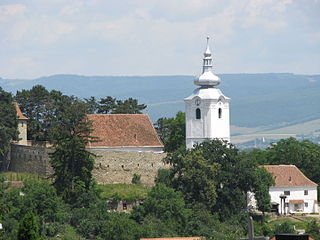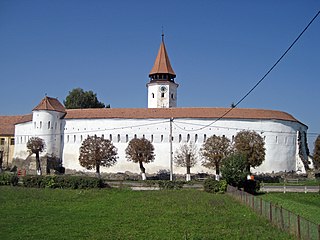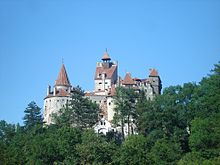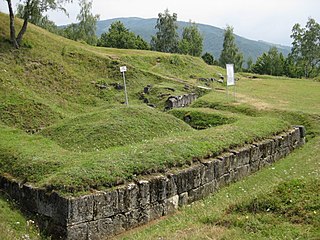.jpg/300px-Bran_castle_(47626731362).jpg) | ||
| Transylvania | ||
| province | ||
|---|---|---|
| Transylvania has no parent region. | ||
| Residents | unknown | |
| no value for residents on Wikidata: | ||
| height | unknown | |
| no value for height on Wikidata: | ||
| no tourist info on Wikidata: | ||
| location | ||
| ||
Transylvania or Transylvania (Romanian Ardeal or Transylvania, Hungarian Erdély) is a region in Romania. The mountainous region in the southern Carpathian region is characterized by its eventful history. In addition to the Germans, there is also a large Hungarian minority living here. The landscape and its romantic castles inspired the horror literature of the 19th century, which established Transylvania as a mysterious and mythical place. The figure of Count Dracula is probably the most famous Transylvanian in popular culture.
Regions
The districts belong to Transylvania (Jewțe) Alba, Bistrița-Năsăud, Brașov, Cluj, Covasna, Harghita, Hunedoara, Mureș, Sibiu, the eastern half of the Sălaj district and smaller parts of other districts.
In addition, is the mountain region Apuseni mainly located in Transylvania.
places

Transylvania was and is a melting pot of different European cultures and peoples. Most of the Transylvanian cities have an intact medieval center. The old town of is particularly worth seeing Schässburg / Sighișoara. Carefully restored in recent years, it impresses with its charm and its location in the valley of the Kokel (Rum. Târnava). Sibiu /Sibiu as European Capital of Culture 2007 and Kronstadt / Brașov definitely belong in this category.
- 1 Kronstadt
 (Brașov). One of the most visited cities in Romania with a very beautiful old town. Until 1920 the city belonged to Austria-Hungary.
(Brașov). One of the most visited cities in Romania with a very beautiful old town. Until 1920 the city belonged to Austria-Hungary. - 2 Cluj-Napoca
 (Cluj-Napoca). The main attractions of Cluj-Napoca are to be found in the city center, whose historic buildings from the time before the Second World War have largely been preserved. Their different architectural styles shape the cityscape. From the earlier period of the history of Cluj-Napoca, the medieval Gothic, of which the most important and best-known example of the city is the St. Michael's Church, Renaissance buildings and the baroque aristocratic palaces from the early modern period are characteristic. In the 19th century and the beginning of the 20th century, numerous representative buildings in the classicist, eclectic and art nouveau styles were built.
(Cluj-Napoca). The main attractions of Cluj-Napoca are to be found in the city center, whose historic buildings from the time before the Second World War have largely been preserved. Their different architectural styles shape the cityscape. From the earlier period of the history of Cluj-Napoca, the medieval Gothic, of which the most important and best-known example of the city is the St. Michael's Church, Renaissance buildings and the baroque aristocratic palaces from the early modern period are characteristic. In the 19th century and the beginning of the 20th century, numerous representative buildings in the classicist, eclectic and art nouveau styles were built. - 4 Neumarkt am Mieresch
 (Târgu Mureș)
(Târgu Mureș) - 5 Karlsburg
 (Alba Iulia)
(Alba Iulia) - 6 Bistritz (Bistrița)
- 7 Diemrich (Deva)
- 8 Iron market
 (Hunedoara)
(Hunedoara) - 9 Sankt Georgen (Sfântu Gheorghe)
- 10 Fagarash (Fagaras)
- 11 Medias (Mediaș)
- 12 Szeklerburg (Miercurea Ciuc)
- 13 Mühlbach (Sebeş)
- 15 Thorenburg (Turda)
Other goals
nature

- 1 Harbachtal
- 2 Retezat National Park
 (Parcul National Retezat)
(Parcul National Retezat) - 3 Bucegi Mountains (Munții Bucegi)
- 4 Fagaras Mountains (Munții Făgăraș). the highest part of the Transylvanian Alps. Its highest peak, the Moldoveanu, is the highest mountain in Romania at 2544 meters.
- 5 Königsteingebirge (Munții Piatra Craiului). The rock favored the creation of a large number of caves and the growth of a considerable variety of plants; there is also a vital population of large carnivores (wolves, bears). The region is well developed for tourism; there is a dense network of hiking trails and several mountain huts and shelters.
- 6 Grădiştea Muncelului-Cioclovina Nature Park (Parcul Natural Grădiştea Muncelului - Cioclovina). Between its borders, the nature park includes six of the most spectacular nature reserves in the Hunedoara region: the Ponorâci-Cioclovina karst complex, the Tecuri cave, the Șura Mare cave, the Crivadiei gorges, the Ohaba-Ponor fossil site and the Bolii cave. At the same time, the archaeological sites of the UNESCO heritage of Sarmizegetusa Regia, Costeşti, Blidaru, Luncani-Piatra Roşie and the authentic ethnographic settlements of the Luncani are located here.
- 7 Turda Salt Mine (Salina Turda), St. Salinelor 3, municipiul Turda. huge and very interesting show mine with a mine museum.
- 8 Piatra Craiului National Park (Parcul Național Piatra Craiului). known for its bears and the bear sanctuary.
Churches
- 8 Hamruden fortified church (Biserica fortificată din Homorod) (403).
- 9 Cincşor fortified church (Biserica fortificată din Cincșor) (103).
- 10 Michelsberg fortified church (Biserica Sfântul Mihail din Cisnădioara) (Pe dealul de la limita sudică a satului).
Castles

- 1 Kendeffy Castle (Castelul Kendeffy). The listed castle was built in 1782. The castle has been used as a hotel since 1984.
- 3 Lázár Castle (Castelul Lazar) (709).
- 4 Sturdza Castle (Castelul Sturdza de la Miclăușeni)
- 5 Bran Castle (Castelul Bran), Moșoiu Traian St., general 495-498, sat Bran; comuna bran. The Bran Castle (Bran) near Kronstadt / Brașov is presented in many tourist guides as Dracula's castle and is one of the biggest tourist magnets in this area. With Dracula or better the historical role model Vlad III. The beautiful complex has nothing to do with Țepeș, but that doesn't change the fascination of the visitors. Of course, there is a large tourist market at the foot of the castle, but mostly goods and souvenirs from local production are still on offer. The birth house of Vlad Țepeș can be visited in Schässburg / Sighișoara near the hour tower. Bram Stoker, the author of "Dracula", who, by the way, has never been to Transylvania, was inspired for his book by medieval reports about this prince.
- 6 Hunedoara Castle (Castelul Corvinilor), Str. Curtea Corvineştilor 1-3, municipiul Hunedoara. The castle is well worth seeing and is one of the most important secular buildings in Transylvania. The rock castle was built on the remains of a fortification from the 14th century. It is located on a limestone rock and is also presented in many tourist guides as Dracula's castle. Today a museum has been set up in the building. The castle is also used as a film set. A large number of Romanian and international film productions were shot on the castle grounds.
- 7 Rosenau Castle (Cetatea Râşnov) (La sud de localitate, pe Dealul Cetății).
- 8 Cantacuzino Castle (Castelul Cantacuzino din Buşteni), Str.Zamora 1, oraș Bușteni.
- 10 Banffy Castle (Castelul Bánffy de la Răscruci), Str. Principală 484, sat Răscruci; comuna Bonțida.
- 11 Kornis Castle (Castelul Kornis din Mănăstirea) (160-161).
In the region are also the ruins of Sarmizegetusa, the former capital of the Dacians and later of the Roman province Dacia, as well as others

Dacian fortresses in the Orăştie Mountains, a UNESCO World Heritage Site. The six fortresses that were built in the murus dacicus technique, which are part of this Dacian group (which were included in the UNESCO World Heritage List), were built between the first century BC and the first century AD for defense and protection against the Roman conquest .
background

Transylvania is at the Interface between Central and Southeastern Europe and because of this location it has a checkered history and a multiethnic or multicultural population.
The settlement area of the ancient people of the Dacians had its center in what is now Transylvania. They formed their own empire, the capital of which was Sarmizegetusa in today's Hunedoara district. In AD 106, the Dacians were dated Roman Empire subjugated under Emperor Trajan and their territory of the province Dacia made. Their capital was called Ulpia Traiana Sarmizagetusa and was about 50 kilometers further south-west than the former Dacian royal city.
During the Great Migration Period, the Goths, Huns, Gepids, Avars, Bulgarians and Slavs appeared here. Sometimes they also settled down or mingled with each other. In the 10th century the land was taken by the Magyars (Hungarians). From 1001, Transylvania belonged to the rulership of the Kingdom of Hungary. In the 12th century, the Hungarian-speaking ethnic group of the Szeklers was resettled in the previously uninhabited border region in the far east. They still make up the majority of the population in parts of the Mureș, Harghita and Covasna districts - the so-called Szeklerland.
Instead, they were in favor of settling central Transylvania German-speaking colonists recruited from the Middle Rhine and Moselle regions as well as Flanders. Your designation as "Saxony" probably goes back to a misunderstanding or a translation error. As a result, “Saxon” and “Saxon” are used synonymously with “German” or “German” in Transylvania to this day. The German settlers were given extensive privileges by the Hungarian king in 1224 in a “golden license” and founded seven important cities: Sibiu, Kronstadt, Bistritz, Schäßburg, Mühlbach, Broos and Klausenburg. This is probably the origin of the German-language term 'Transylvania' for this area. In Hungarian, on the other hand, is from Erdély the speech, which means something like "beyond the forest", which means the wooded Apuseni Mountains. This also includes the Romanian names Ardeal and Transylvania (from the Latin translation Transylvania) derived.

In the following centuries, further waves of migration came from the German-speaking area. In particular, during the Counter Reformation, Protestants moved from the Austrian rulership to Transylvania, where freedom of belief was valid. Another example were unpaid families with many children from Baden-Durlach.
The Romanians of Transylvania were disadvantaged and marginalized for centuries. Unlike Saxony, Hungary and Szekler, from 1437 they no longer had their own assembly of estates. In most of the cities that were dominated by Germans, they were not allowed to settle at all or to engage in any trade until the 19th century.

One of the most famous personalities associated with Transylvania was Fürst Vlad III. Wallachia, the one with the surname Drăculea ("Son of the Dragon") and Țepeș ("Impaler") was provided. He was probably born in 1431 Sighișoara (Schäßburg), but brought hostage to Turkey as a child and later ruled over the Wallachiabut not about Transylvania. Reports of his cruelty have been exaggerated and embellished by his political opponents. The horror figure of the legends, which spread beyond the Balkans to the German and Russian-speaking regions, has little to do with the historical person. Between Bram Stoker's fictional character, the vampire Count Dracula, and the real late medieval prince, apart from the name and the Transylvanian homeland, there is certainly nothing in common. By the way, many Romanians adore Vlad Țepeș as a hero, for them he stands for “brutal” honesty and a ruthless fight against corruption and crime. In order to attract tourists, various places in Transylvania claim a reference to Drăculea, but in fact none of them has a guaranteed, closer connection to it. Prince Vlad stayed at the castle for a short time Hunedoara on, but - contrary to what is sometimes claimed - he was no more their owner than Bran Castle (or Bran Castle) with him Brașov belonged to, which he probably never even entered. Nonetheless, both are very romantic and well worth seeing. The building in Sighișoara, sometimes referred to as Dracula's birthplace, wasn't even erected until two centuries later. Nevertheless, the medieval center of this city is definitely worth a visit - Dracula or not.
Was a contemporary of Prince Vlad Matthias Corvinus, who was King of Hungary from 1458 to 1490 and is very revered there, as the country flourished under his rule and he successfully opposed the Austrian Habsburgs. He was born in Cluj-Napoca (today Cluj-Napoca) and was the son of the then governor of Transylvania. The house where he was born in Cluj has been preserved and the castle was actually owned by his family Hunedoarathat is why in Romanian Castelul Corvineştilor ("Corvinus Castle") is called.
In the 16th to 17th, Transylvania was in the middle of the conflict zone between the Ottoman Empire, which ruled large parts of the Balkans, on the one hand, and Hungary and the Habsburg Monarchy on the other. After the defeat by the Turks and the death of the Hungarian king in 1526, the Kingdom of Hungary was temporarily split in two. Transylvania belonged to the eastern half under the rule of the noble family Zápolya. This recognized the Ottoman sultans as sovereigns. Nevertheless, there were repeated Turkish raids and massive kidnapping. From 1570 onwards, Transylvania was largely a autonomous principality, whose regents were temporarily vassals of the Ottoman Empire, and temporarily of the Habsburg Empire. During that time, the country often suffered from epidemics, famine, horrific taxes and tributes, and the rulers' lust for war.

From 1711, Transylvania was then permanently part of the Habsburgs ruled the Kingdom of Hungary, but still enjoyed some autonomy. This did not end until 1867 when Transylvania became part of the centrally administered Hungarian half of the empire with the Austro-Hungarian settlement. Since the Hungarians were in the minority in their own country, the government tried to "Magyarize" the other ethnic groups - namely Germans and Romanians - that is, to make Hungarians linguistically and culturally, which, however, hardly succeeded.
After the end of the First World War and the fall of the Danube Monarchy, Transylvania became part of Romania handed over, which was initially also advocated by the assembly of the Transylvanian Saxons. However, some of the non-Romanian ethnic groups were now disadvantaged or even expropriated. Some Magyars emigrated to central Hungary, Romanians from Moldova and Wallachia were settled in Transylvania, which shifted the majority relations between the ethnic groups in many places. Most of the Transylvanian Saxons stayed, however. During the Second World War, Transylvania was divided between 1940 and 1944: the northern part was annexed to Hungary, the southern part remained with Romania.
After the end of the war, there were attacks against the German and Hungarian populations, who were accused of collaborating with fascist Germany and Hungary. Some of the Saxons emigrated to Germany or Austria, but the majority stayed until the 1980s. Then there was another massive wave of emigrationwhen the communist-nationalist dictator Ceaușescu pursued policies that were hostile to minorities and the economic situation also deteriorated significantly. The Federal Republic of Germany paid Romania a “head premium” for every German resettler who was allowed to leave the country. After the borders were opened in 1989 at the latest, most of the remaining Saxons moved to Germany.

In the 2002 census, almost 75% of the population were Romanians, almost 20% Magyars (Hungarians), a good 3% Roma and only 0.7% Germans. The largest religious group are the Romanian Orthodox (almost 65%), followed by the Roman Catholic Church (11%), the Reformed (10%), and the Greek Catholic Church (just under 3%).
language
Transylvania is in Romania, so mainly Romanian spoken. There is also a large one in Transylvania Hungarian Minority (almost 20% of the population, in the Harghita and Covasna districts they even make up the majority) as well as a German minority - the Transylvanian Saxons, which has decreased to around 14,000 since the 1990s. However, these mostly speak their specific dialect, which can appear somewhat archaic to Germans, Austrians and Swiss due to the relative isolation from the rest of the German-speaking area. The strongly rolled 'R' is particularly noticeable. In addition, German schools such as For example, the Brukenthal Lyceum in Sibiu has a high reputation among Romanians and German is offered as a second language at some high schools. Therefore there is a certain chance that Transylvanian Romanians speak this language as well. The large group of Roma with their own language, Romani, should not be forgotten.
getting there
Bigger ones Airports available in Cluj (accessible from Basel, Dortmund, Geneva, Cologne, Maastricht, Memmingen, Munich, Nuremberg, Vienna), Târgu Mureș (from Dortmund, Hahn, Karlsruhe, Memmingen) and Sibiu (from Dortmund, Cologne, Munich, Stuttgart, Vienna, Memmingen and Nuremberg). Most of the flights are from the Hungarian low-cost line Wizz Air carried out.
All major cities in Transylvania can be reached with the train above Budapest (Hungary). A daily night train (EuroNight) from Vienna to Bucharest stops in Deva, Alba Iulia, Mediaș, Sighișoara and Brașov, among others.
With the automobile you drive the approx. 650 kilometers from Vienna to Cluj in a good eight hours. It is almost 800 kilometers to Sibiu, for which you also need a good eight hours - as it is mostly on the motorway.
mobility
The region is well per train to travel. However, you should plan some time for the train journeys. Traveling by train in Romania is definitely recommended for the interested tourist, there is nowhere better and faster to get into conversation with the locals, and the beautiful landscape makes up for the slowness of the journey.
There are currently three types of train in Romania: Regio (R) - "slow trains" that stop everywhere; InterRegio (IR) - slightly faster through trains; and the InterCity (IC) - not really as fast as a German Intercity, but almost as expensive.
The so-called sat down more and more Microbuses or maxitaxis by, small intercity buses that take passengers to all cities in the region for about the same price as the train, near train stations or at bus stations. These can often be recognized by the cardboard signs with the aim in the windshields. They usually stop on the way and let travelers off and on. Payment is usually made to the driver, usually before reaching the destination when boarding. (It is helpful to observe the locals here, to ask and to do the same to them.)
Driving by Hitchhikers is often the only way to get ahead between the small towns, it is widespread and can easily be done by strangers. The driver of the car expects a small tip to take away. For the route Reps / Rupea - Kronstadt / Brașov (60 km), around 8 lei have to be paid in 2007. The smallest unit here is the 1-lei note, for example between two villages.
One possible route that connects all of Transylvania’s major cities is z. E.g .: (from direction Baia Mare or Satu Mare coming) → Zalau → Cluj-Napoca → Bistrița → Târgu Mureș → Sighișoara → Brașov → Fagaras → Valea Hârtibaciului → Biertan → Mediaș → Sibiu → Alba Iulia → Hunedoara → (continue after Reșița or Timisoara).
activities


The very varied landscape of Transylvania is shaped by the Carpathian Mountains and their foothills. The hike in the mountains is particularly popular with tourists from the German and English-speaking areas, and so there are already some well-developed mountain huts (cabana) and some marked hiking trails. The Bucegi Mountains and the Piatra Craiului (Königstein) Mountains (both in the Kronstadt / Brașov district), as well as the Fagaras Mountains are recommended here.
The Piatra Craiului- (Königstein) Mountains are a popular destination for alpine hikers and climbers; In the Piatra Craiului- (Königstein) gorge there is a whole series of well-developed and signposted climbing rocks as well as a mountain rescue station. The gorge can be reached from the small town of Zărneşti, or even closer, from the mountain village of Măgura. Here is also the one known for hiking holidays Pension Villa Hermani in Magura.
In the plain and in the low mountain ranges there are trips and tours with the bicycle quite possible. There are of course no cycle paths, but the mixed traffic in Romania is an advantage for the cyclist here, because he is in the company of horse-drawn carriages and other "slow drivers". A stable mountain bike is required for two-wheeled locomotion in the mountains.
motorcycletravelers also get their money's worth here. Not only because of two of the most beautiful pass roads in Europe, the Transfăgărăşan and the Transalpinacrossing the Carpathian Mountains between Transylvania and Wallachia. There are also plenty of other small, winding roads through the breathtaking landscape of Transylvania. Whether athletes, tourers or travel enduro, everyone will find their territory here.
Winter is in the Carpathian Mountains Winter sports possible. However, mostly not in the way modern Western Europeans imagine. Rather, you have to carry your skis or sledges up the mountain in the classic way before you can enjoy the joy of the descent. A modern ski area with a cable car and groomed slopes can be found e.g. in the winter sports resort of Schullerau / Poiana Brașov.
On the river Alt / Olt you can go with the raft drive (here are pictures of one Raft tour on the Olt).
kitchen
To a certain extent, the cuisine of Transylvania forms a link between those of Romania, Hungary and the southern German-Austrian region. Each of the ethnic groups has its own cooking tradition, but these have mutually influenced and partially harmonized one another over time. With the Romanians there are z. B. typically sour soups (Ciorbă), dishes spicy hot with paprika and caraway seeds in the Hungarians and meat soups with fruit inlay (such as plum, grape or rhubarb soup) and pastries among the Germans. The staple food is corn porridge (Romanian Mămăligă, Hungarian Puliszka, Transylvanian-Saxon Palukes; similar to Italian polenta), potatoes (in the form of boiled or fried potatoes, potato mash or puree) and dark, heavy brown bread that is baked in very large loaves and z. B. is eaten as lard. More about this in Wikipedia article.
nightlife
security
Transylvania is a safe country to travel to. The usual precautionary measures are usually sufficient: Do not leave valuables in the car or anywhere unattended.
The telephone number of the police in Transylvania and all of Romania is 955. Emergency call center: 112. Traffic police: 9544. Emergency doctor: 961. Fire department: 981.
In general, Romanians are very open and helpful towards strangers. Only the traffic has a more oriental character. Here you should be prepared for wild overtaking maneuvers and also for making room for the one overtaking. They often cut in at the last second before they crash into oncoming traffic. There are still many horse-drawn wagons on the streets that are unlit at night and are often difficult to see. It can also happen that there are animals on the road behind a curve.
health
The Romanian state health system is not up to Western European standards. Although the medical staff is very well trained, the hygienic conditions do not correspond to what you e.g. B. is used to in Germany. The staff is underpaid and often overwhelmed with the number of patients. If possible, it is advisable to switch to private hospitals etc. Their equipment and scope of services usually correspond to the Western European standard.







.jpg/180px-RO_BN_Biserica_evanghelica_din_Bistrita_(51).jpg)



.jpg/350px-RO_BV_Fagaras_2019_(1).jpg)
















.jpg/244px-Saschiz_Church_Tower_(8154793110).jpg)
.JPG/350px-Biserica_evanghelica_fortificata_din_Valea_Viilor_(29).JPG)











.JPG/350px-CastelulKendeffy_(10).JPG)
.jpg/285px-RO_HD_Cetatea_Devei_2018_(3).jpg)



.jpg/350px-Corvin_Castle_-_Hunedoara,_Romania_-_Travel_photography_(36729360851).jpg)














